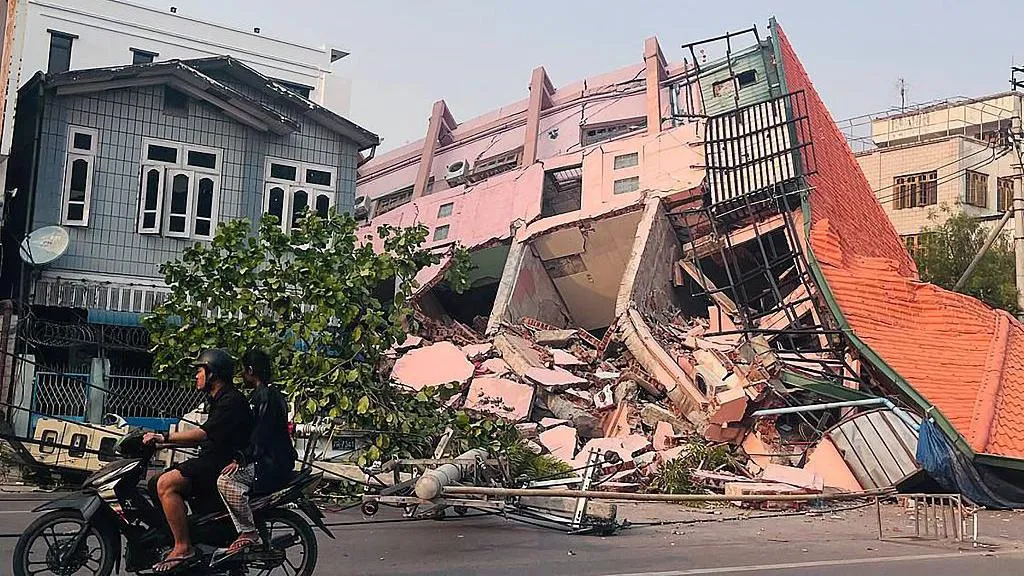March 29, 2025 – A devastating 7.7 magnitude earthquake struck central Myanmar on Friday, leaving at least 144 people dead and over 732 injured, according to Myanmar’s military leader, Min Aung Hlaing. The powerful quake, which originated 16 kilometers (10 miles) northwest of Sagaing, sent shockwaves that were felt as far as southwestern China and neighboring Thailand.
In Thailand, the earthquake caused a high-rise building under construction in Bangkok to collapse, resulting in the deaths of at least seven people and leaving around 100 construction workers unaccounted for. The Bangkok Metropolitan Administration confirmed the deaths and reported that emergency teams are still working to locate and rescue the missing individuals.
Severe Damage in Myanmar and Sagaing Epicenter
The epicenter of the earthquake was located near Sagaing, a region with a population of over 1.5 million people. The tremors were so intense that they caused roads to buckle in the capital, Nay Pyi Taw, and led to widespread destruction across central Myanmar. Buildings in major cities, including Mandalay and Yangon, were severely damaged, and power outages were reported in several areas.
Rescue workers in Mandalay described the destruction as “enormous,” with thousands of people displaced and in urgent need of assistance. Many families have been forced to seek shelter in makeshift camps as they await aid. The extent of the damage in remote and rural areas is still being assessed, but preliminary reports suggest that entire villages may have been destroyed.
Aftershock Worsens Situation
A powerful aftershock measuring 6.4 on the Richter scale followed just 12 minutes after the initial quake. This secondary tremor struck 18 kilometers (11.1 miles) south of Sagaing, compounding the destruction and making rescue efforts even more challenging.
Rescue operations are underway, but emergency responders are facing significant obstacles due to the extensive damage to infrastructure and ongoing aftershocks. Roads have been rendered impassable, hampering efforts to deliver aid to the most affected regions.
State of Emergency Declared
In response to the disaster, Myanmar’s military government declared a state of emergency in six regions, including Sagaing, Mandalay, and Nay Pyi Taw. The junta has called for international assistance to aid in rescue and relief operations, marking a rare appeal for foreign support.
The junta’s emergency declaration includes deploying military personnel and national disaster response teams to coordinate search and rescue operations, provide medical aid, and establish temporary shelters for displaced families. However, relief efforts are being complicated by the political and logistical challenges that have plagued Myanmar since the military coup in 2021.
Tragedy in Thailand: High-Rise Collapse in Bangkok
In Thailand, the earthquake’s tremors caused a tragic collapse of an unfinished high-rise building in Bangkok, hundreds of miles from the epicenter. The Bangkok Metropolitan Administration reported that at least seven people were killed in the incident, and around 100 construction workers remain missing.
Emergency responders are working tirelessly to sift through the rubble in hopes of finding survivors. Rescue operations in Bangkok are being hampered by the unstable structure of the collapsed building, which has made it dangerous for teams to navigate through the debris.
Humanitarian Crisis and International Assistance
The scale of the disaster has triggered an urgent need for humanitarian assistance in Myanmar, where thousands of people have been left homeless and medical facilities are overwhelmed. Blood supplies are critically low, and hospitals are struggling to treat the injured due to a shortage of resources and medical personnel.
In response to the crisis, several countries have already pledged support and dispatched rescue teams:
- China has sent specialized search and rescue teams along with medical supplies to assist Myanmar’s response efforts.
- India has deployed emergency response teams and humanitarian aid, including essential supplies and medical equipment.
- Russia has mobilized disaster response experts to support rescue operations and provide critical assistance in affected areas.
The United Nations and international humanitarian organizations are also coordinating relief efforts, with an emphasis on delivering aid to the hardest-hit regions.
Challenges in Relief and Recovery Efforts
Myanmar’s ongoing political turmoil and restrictions on information flow are making it difficult for humanitarian agencies to assess the full extent of the damage and coordinate relief efforts effectively. Since the military seized power in 2021, the junta has maintained strict control over media and internet access, limiting the availability of accurate information from affected areas.
The situation is even more precarious in rebel-controlled regions, where communication is limited, and humanitarian access is restricted. According to recent reports, the affected areas are now under the control of a patchwork of groups, adding another layer of complexity to relief operations.
Historical Context: A Nation in Turmoil
Myanmar, formerly known as Burma, gained independence from Britain in 1948. The country has experienced prolonged periods of unrest and conflict, with the military seizing power in 2021, a decade after allowing a civilian government to take control. Since then, the junta has cracked down on dissent, executing democracy activists and jailing journalists.
The military’s iron grip on information and communication has led to challenges in gathering accurate data, making the earthquake’s impact harder to assess, particularly in rebel-held regions. The government’s recent call for international assistance highlights the gravity of the situation and the urgent need for coordinated global support.
Future Outlook: Growing Concern for Survivors
As rescue operations continue and international aid pours in, the death toll is expected to rise in the coming days as more bodies are recovered from the rubble. With thousands displaced and critical infrastructure damaged, the humanitarian situation is likely to deteriorate further unless immediate and sustained support is provided.
Emergency responders are racing against time to save lives and provide relief to those affected by this catastrophe. However, the complex political and social landscape in Myanmar presents a significant challenge to the success of these efforts. The world is now watching as Myanmar struggles to recover from one of the most devastating earthquakes in its history.



0 Comments